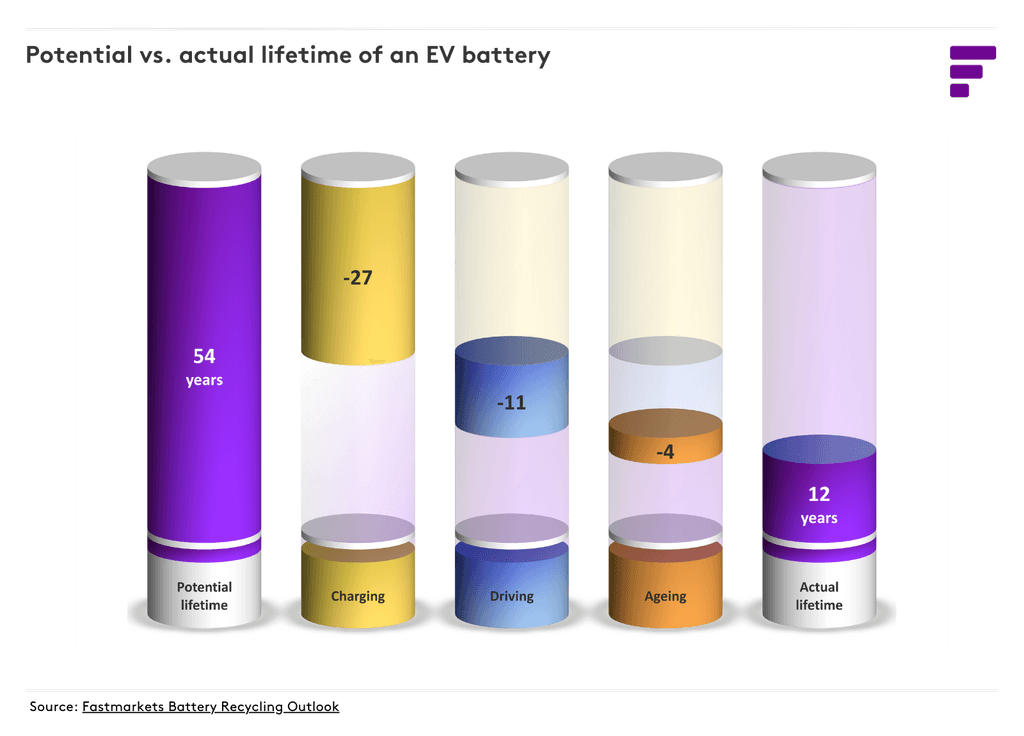Key article takeaways:
- The longevity of lithium-ion batteries is key to sustainable practices and efficient EV battery recycling processes
- EV batteries typically last 8-10 years, though some show potential to extend beyond 15 years
- Battery type, application and utilization rates, significantly impact EV battery lifespans
- Degradation in lithium-ion batteries occurs due to electrochemical and mechanical effects, leading to reduced capacity over time
- Research focuses on extending EV battery lifespan through second-life applications and innovative technologies to support sustainability
Looking to stay ahead in the emerging battery recycling market? Keep up-to-date with forecasts and outlooks for black mass and recycled battery raw materials with our Battery Recycling Outlook. Find out more.
What is the lifetime of an EV battery?
In a world powered by batteries, their lifespan becomes the heartbeat of innovation and sustainability. Therefore, when working within the battery value chain, it is important to know the lifespan of a battery when projecting industrial processes or applications.
The general accepted industry standard and warranty for the lifetime of an EV battery is between 8-10 years. However, real-world examples like Prius (although hybrid), suggest that batteries can endure much longer than initially anticipated, with instances of over 15 years without needing replacement.
Why it is important to understand EV battery lifetimes
The lifetime of a battery, or the specific time a battery can last depends on the type of battery, the application that it is serving and the utilization rate that it is subject to.
Understanding the expected lifespan of a specific battery is crucial, influencing the availability of end-of-life batteries for entry into second-life or recycling markets. This knowledge is also valuable for predicting supply volumes of critical raw materials like lithium and promoting sustainability in the battery value chain. Fastmarkets is forecasting a 12% contribution from battery recycling to the total metal supply by 2033, a significant factor for Original Equipment Manufacturers (OEMs) in warranty assessments for their products.

Causes of EV battery degradation
If we take a standard lithium-iron phosphate (LFP) battery that can last 2000 cycles before dropping below 80% of its capacity (level from which below the battery is not suitable for continued use for its purpose), with a range of 300 km, it could, in theory, last for 600,000 km before being discarded.
Considering that the average EU driver drives 11,300 kilometers per year, theoretically a battery could last for 53 years. However, this value is not realistic since batteries suffer different forms of degradation throughout their lifetime, which then significantly decreases this hypothetical value.
Batteries experience degradation over time, leading to a decrease in capacity and an increase in internal resistance. This happens even if the battery is not being used at all, which we could call the ‘natural ageing’ of a battery.
According to some studies, battery degradation can be around 1.6-2.3% annually, independent of its use. Tesla recently announced that it is only facing 12% degradation in its batteries after 322,000 kilometers and that they still hold 88% of their capacity after 14 years (average US driver, Federal Highway Administration).
Key causes for the battery degradation can include:
- Electrochemical effects like the growth of the Solid Electrolyte Interface (SEI), that consumes lithium and therefore reduces capacity. This happens even if the battery is not being charged/discharged
- Mechanical effects like micro fracturing, exposing more surface and accelerating the continuous degradation, acting like a positive-feedback mechanism
- Lithium platting, where the lithium ion, instead of going into the graphite, form to become metallic, reducing capacity.
All these physical-chemical mechanisms act to reduce the lifetime of a battery and are accelerated by environmental factors, such as the charging pattern of a battery, the operating temperatures and driving behavior.
Fastmarkets has modeled the lifetime of an EV battery (considering the ageing mechanism, charging behavior and operating temperature). We put this figure at a range between 22 years, for an optimal usage of the battery in optimal conditions, five years for the worst-case scenario and an average of 12 years.
Difficulties in determining the State of Health (SoH) of an EV battery
At present, the current understanding on the lifetime of the battery is based on laboratory tests and not on field performance. More accurate lifetime prediction improves battery technology at all stages of a battery’s life*. This leads to improved prospects for second-life applications. Supporting the creation of a circular economy around battery manufacturing, re-use and recycling will also be critical as demand is forecast to outpace raw material supply and refinement over the coming decade.
Finally, at the end of its first life, a battery may be assessed for possible second life applications (e.g. grid storage). Estimating health at this point comes with additional difficulties, such as potential lack of historical data and a change in the future ageing mechanism of the battery due to different operating conditions in second life*. This is where the concept of battery passports come in. This tool, which is being introduced as regulatory policy, has been pursued by the EU to trace the sourcing of materials, manufacturing processes, energy storage capacity, usage history and disposal or recycling of batteries. The blockchain technology will act as a safe, clear and unchangeable record for tracking the lifecycle of a battery.
Second life and future battery research will extend EV battery lifespan
Besides second life, there is also some promising research around the way to counter battery ageing. The life of a battery could theoretically be further extended – some speculating that this could be extended to one million miles for EVs. For example, researchers from the electromobility research centre in Belgium’s Vrije University are looking into ways that batteries could repair themselves, enabling the life of the battery to be extended for 5-10 years using polymeric materials to both protect and repair the mechanical degradation of the crystals in the electrodes. Currently, these techniques are expensive and complex to build and are confined to laboratory scale.
Supply of EV batteries will take longer than expected
In conclusion, it’s most likely that the lifespan of EV batteries will surpass the typical 8-10 years warranty offered by OEMs. This extended lifespan could result in batteries being used in vehicles (both first and second-hand) for 10-15 years, followed by 5-10 years of second-life utilization. Additionally, ongoing research aimed at enhancing battery longevity could further delay their arrival at recycling facilities. As a result, we may see many of these batteries reaching recyclers 20 or more years after being produced.
*Sulzer et al. 2021
Want more insights and forecasts for the battery recycling and black mass market?
Keep up to date with global market insights and predictions for the battery recycling and black mass markets with our black mass newsletter. Sign up now.





